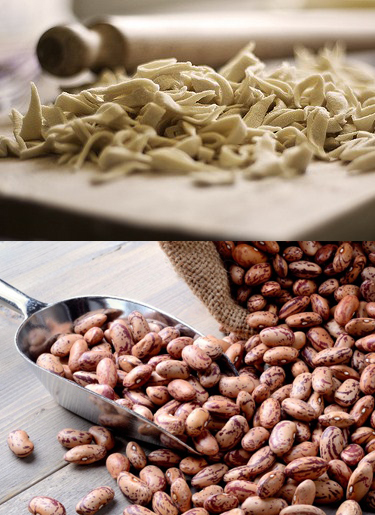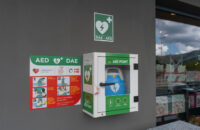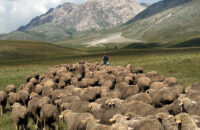Beans, fresh homemade pasta and a few simple ingredients for a rich and wholesome dish: it is the queen among all soups, pasta e fagioli, which enriches the culinary tradition in Abruzzo.
Typical of this dish are sagne, also called sagnette or tagliolini, a short pasta characterized by a dough made from water, durum wheat flour and salt.
In the past, the poverty of the ingredients made this pasta suitable for everyday lunch, as opposed to the egg pasta typical of feast days. This culinary tradition has remained unchanged over the years: even today it is on feast days that people devote more time to cooking, preparing rich pasta dishes such as the classic chitarra, ravioli or lasagna, while during the week they prefer the poorer pasta, made with water and durum wheat semolina.
Pork rinds are added in the richer variant of pasta and beans, while today’s version is the basic one made with only vegetable ingredients.
THE RECIPE.
 Ingredients
Ingredients
250 g dried borlotti beans
250 g tomato puree
1 carrot
1 onion
For the pasta
400 g remilled durum wheat semolina
enough water
1 pinch of salt
1 celery stalk
2 bay leaves
salt
Preparation
Let the beans soak for at least 12 hours.
After 12 hours have passed, remove the beans from the soaking water and pour them into a large saucepan, add the finely chopped celery, carrot and onion, tomato and bay leaf, cover with plenty of water and leave to cook over low heat until the beans are soft, which will take about 2 hours.
We salt only at the end of cooking to prevent the beans from becoming hard.
In the meantime, let’s prepare the dough: pour the flour into a bowl ( or prepare the classic
fountain on a pastry board), add a pinch of salt and add water ( at room temperature ) as much as necessary to obtain a homogeneous dough; knead well and form a ball, then let the dough rest, covered with plastic wrap, for at least 30 minutes. We roll out the dough with a rolling pin on a lightly floured pastry board, form a rectangle of medium thickness and cut out long strips of dough with a height of about 34 cm, dust with semolina and overlap the strips, then cut with a sharp knife forming the sagne.
When cooking beans, we always keep a pot with hot water or vegetable broth on the stove to add to the pot with the beans as needed.
Bring a pot of water to a boil, add salt and cook the pasta for a few minutes until it comes back to the surface; when it is cooked, add the pasta to the beans, mix well and bring to the table.
Before serving, add a drizzle of oil or freshly ground pepper to taste.
Tips
– for cooking beans we can also proceed in another way: after soaking,
cook the beans with water and bay leaves ( and herbs to taste such as
rosemary and sage ), once cooked we salt them and keep them aside; prepare a sautéed
with finely chopped celery, carrot and onion, brown them with a few tablespoons
of oil, then add the beans, tomato and water and let them season for about
30 minutes, then add the pasta ( already cooked );
– for cooking fresh pasta, so that it does not stick while cooking, we can add a
tablespoon of olive oil to the boiling water;
– you choose the thickness of the pasta, but sagne should not be too thin.
Source : www.tastefromabruzzo.com







